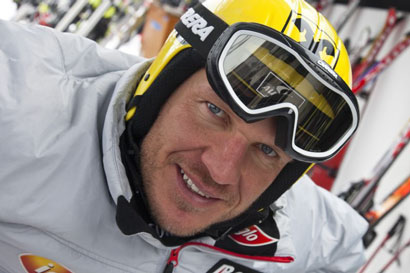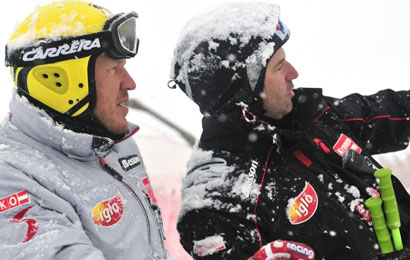There is a saying in English that says things get better with age. Approaching the beginning of the 2008 - 9 FIS Audi World Cup season, it had been almost three years since Hermann Maier had stood on the top step of the podium at a World Cup race. Talk was more of Maier retiring than him gracing the top step again. Olympic medals, World Championship medals and Crystal Globes had all been achieved: Maier is one of the Greats of the sport. Yet while father time is catching up with him, there is still the desire in his heart to win again. Quality products have an enduring life span and so it is with the Rolex Testimonee, Hermann Maier.

Hermann Maier (AUT) before the start of the second Downhill Training Photo by: Rolex / Daniel Forster
In the summer of 2008, Maier looked at a lot of things: safety, health and what course his life would take all occupied him. Maier was invited as a consultant to the International Ski Federation's offices in Oberhofen to help in the discussions to improve safety equipment for ski racers yet was unable to attend due to a bout of flu that kept him sidelined for a month. Safety is a subject close to Maier's mindset. Considering the number of brushes with disaster that the 36-year old Austrian has had, it is understandable why he is keen to be involved in the discussions over safety. From the spectacular fall in Nagano in 1998 after which Maier recovered to win two Olympic Gold medal just days later, to his comeback from the motorbike accident in 2001, Maier has endured it all, and as a Testimonee of the Rolex brand he clearly bears witness to the excellence of the product.

Hermann Maier and his team manager discuss the course after the 1st Downhill Training was cancelled Photo by: Rolex / Kurt Arrigo
Maier is the revered older statesman of the World Cup. In Val Gardena, he was part of a group of racers that Gunther Hujara, the Race Director of the Men's World Cup, called together to discuss a range of safety issues. Maier's views and opinions, Hujara admitted afterwards, will help the safety of the next generation of racers on the World Cup and below. Ski racing can be a dangerous sport but with the right tools and equipment, safety is paramount.
Yet throughout the summer of 2008, there was still unfinished business: the will to win, he still had thoughts of winning again! Summer training went well and having admitted that “in the springtime I was ready to stop my career,” Maier decided that he could and would continue. Maier excels in many fields that Rolex is known for: quality, know-how, performance and being made to last.
With 53 World Cup wins already on the board, 54 if you count the Val d'Isere Giant Slalom where he was disqualified for taking his ski off above the red safety line in the finish area, Maier still has the hunger and desire. His 2008 - 9 season did not start off particularly well with a disappointing Giant Slalom in Solden, yet by refocusing his goals and aims for the season as well as his strengths, Maier went to North America with much to prove. Those that wrote him off prior to Lake Louise did so at their peril. Maier used the conditions and his heart to great effect to score one of the most popular and heart warming wins seen recently. Maier's win saw him become the second oldest World Cup winner. To have only started racing on the World Cup at 24 and yet to have won so many races underlines the true strength and power of Hermann Maier.
Talking after the race in Val Gardena just prior to Christmas, Maier discussed his thoughts about the race and what he would like to be giving his fellow racers for Christmas: “My skiing today was their Christmas present,” the popular Austrian joked. Since his win in Lake Louise, Maier is relaxed and content with the way things are. The rugged power and determination of Maier pre his motorbike accident has now given way to a different type of power and determination: Without one you could not have the other. The win in Lake Louise meant so much to him - three years without a win for a man who became so accustomed to winning was hard for him to take.
Maier still has goals he is looking to achieve before he finally hangs up his boots and skis. Winning at Val Gardena, one of the Classics, is something that has so far eluded him and is something that he would dearly love to achieve. “After Lake Louise this year,” Maier told the press after the race in December 2008, “everything is a bonus.” According to Roberto Brunner, Media Officer for the Austrian Ski Team, ever since he appeared on the circuit as a raw talent, his charisma and personality have shone through. Maier has scored over 2,000 World Cup points in a single season and he has won races by margins not deemed possible. To win one World Cup race is a great achievement, to win thirteen World Cup races in one season, a record in itself, is what makes greatness. In 1999 Maier won three races in Beaver Creek in five days. Maier does not dwell on such records but looks to the next race and winning that.
Maier no longer races in the Giant Slalom: the toll on his knees has seen to that. The man who has won four Overall World Cup Titles (1998, 2000, 2001 & 2004) still has other impressive records to uphold: He has never finished lower than second in the Kitzbuehel Super G including five wins. In 2008 a small mistake near the end looked to have cost Mr Kitzbuehel dearly yet when he crossed the finish line to the roar of the crowd, he realised that the story would roll on.
Even at 36 years old, Maier has the pull and attraction for ski racing fans the world over. The current enfant terrible of ski racing, American Bode Miller, gave this reflection of the great Austrian to the American Ski Racing magazine: “When Herman was in the start house years ago, he was demanding that he do something so far ahead of what anyone else was trying to do. So, even if he did 80%, he was miles ahead of everyone else. He wasn't shy about making mistakes. His confidence in his ability was huge." Maier is still the racer that many aspiring racers gauge their results by.
When Hermann Maier talks people listen, from humble beginnings, Maier has forged a solid and distinctive brand. He is the most successful and charismatic racer still competing on the Men's World Cup tour. Roberto Brunner adds: “There are few real characters on the World Cup yet Hermann is definitely one of them.” In the finish area after a race, Maier draws the journalists like maybe only one other racer, Bode Miller.
To listen to Maier talk about Kitzbuehel is inspiring. From the sheer acceleration at the start and over the Mausefalle, up to 80kmh within three seconds, and on to the Steilhang; this is where Hermann Maier is in his element. After the comparative tranquillity through the trees in the Bruckenschuss and emerging out at Alte Schneise it is then onto Seidlalm. With the muscles burning and the roar starting to build, Maier becomes passionate and visual as he describes the places where tenths of seconds are won and lost. After the Larchenschuss and the Hausbergkante, the roar approaches deafening proportions as Maier's fans urge their favourite on. The speed generated down the Zielschuss and over the Zielsprung is what separates the men from the boys. This is what downhill racing is all about; it is not for the feint of heart. This is man and his skis against the mountain.
As the crowds pour into Kitzbuehel in January, the red white red flags will be in abundance yet the legendary Hahnenkamm roar will be loudest when the man with the distinctive yellow helmet appears over the Hausbergkante and into sight. This is the man the fans have come to see. This is the man that embodies everything that the man in the street aspires to: This is Hermann Maier.
January 19, 2009
www.hahnenkammnews.com
Hahnenkamm-Race
Kitzbuehel, Austria
January 23 - 25, 2009

| 

